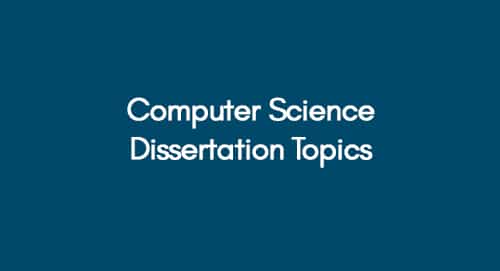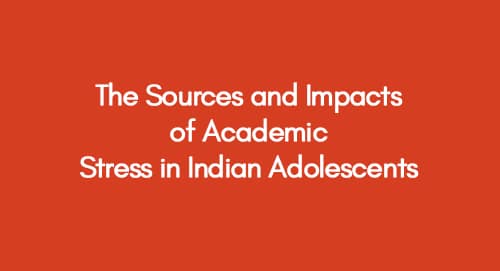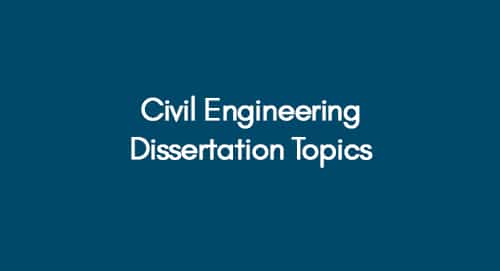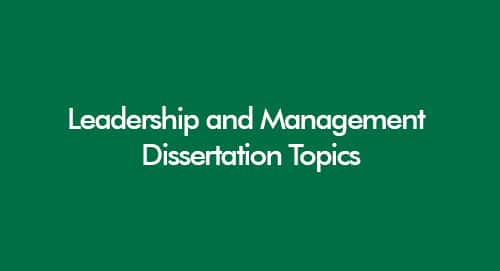
Computer Science Dissertation Topics | 25 Trending Ideas in 2024
September 26, 2022
The Sources and Impacts of Academic Stress in Indian Adolescents: A Quantitative Study
September 29, 2022Civil engineering is a diverse field of study that includes designing, building, supervising, and maintaining infrastructure projects in both private and public sectors. Civil engineers oversee construction projects from start to finish. Research in civil engineering helps develop better construction methods. Thus, students must look for new civil engineering dissertation topics for their dissertation modules.
Engineering Dissertation Example
The expert civil engineering researchers and writers have prepared a list of research topics in civil engineering for 2025.
Construction Engineering Dissertation Topics | Engineering Management Dissertation Topics
List of New Civil Engineering Research Topics For 2025
Best Dissertation Topics in Civil Engineering
Trending Civil Engineering Thesis Topics 2025
Most Researched Civil Engineering Thesis Topics
Quality Civil Engineering Research Topics For Undergraduate Students in 2025
Topic 21. Analysing the Impact of Sustainable Materials in UK Construction Projects: A Systematic Study
Topic 22. Examining the Role of Smart Cities in Enhancing Urban Infrastructure in the UK: A Case Study
Topic 23. Assessing the Environmental Benefits of Permeable Pavements in Urban Areas: A Quantitative Study
Topic 24. Understanding the Effectiveness of Rainwater Harvesting Systems in UK Residential Buildings: A Qualitative Study
Topic 25. Evaluating the Impact of Climate Change on Bridge Design Standards in the UK: A Systematic Study
Topic 26. Analysing the Efficiency of Modular Construction Techniques in Reducing Project Timelines: A Case Study
Topic 27. Examining the Use of Artificial Intelligence in Predictive Maintenance of UK Infrastructure: A Qualitative Study
Topic 28. Assessing the Resilience of UK Coastal Defenses Against Rising Sea Levels: A Quantitative Study
Topic 29. Understanding the Role of Geotechnical Engineering in Minimizing Soil Erosion in the UK: A Systematic Study
Topic 30. Evaluating the Performance of Zero-Carbon Buildings in the UK: A Case Study
Topic 31. Analysing the Impact of High-Speed Rail Networks on Regional Development in the UK: A Quantitative Study
Topic 32. Examining the Adoption of Green Concrete in the UK Construction Industry: A Qualitative Study
Topic 33. Assessing the Effectiveness of Pedestrianized Zones in Reducing Urban Air Pollution: A Case Study
Topic 34. Understanding the Impact of Wind Load on Tall Buildings in UK Urban Areas: A Systematic Study
Topic 35. Evaluating the Integration of Renewable Energy Systems in UK Building Designs: A Quantitative Study
Topic 36. Analysing the Efficiency of Tunnel-Boring Machines in Urban Infrastructure Projects: A Case Study
Topic 37. Examining the Role of Civil Engineering in Achieving Net-Zero Targets in the UK: A Systematic Study
Topic 38. Assessing the Impact of Advanced Drainage Systems on Flood Prevention in the UK: A Quantitative Study
Topic 39. Understanding the Challenges of Retrofitting Heritage Buildings for Energy Efficiency: A Case Study
Topic 40. Evaluating the Use of Virtual Reality in Civil Engineering Education and Training: A Qualitative Study
Topic 41. Analysing the Role of Sustainable Urban Drainage Systems in Mitigating Urban Flood Risks in the UK: A Systematic Study
Topic 42. Examining the Impact of BIM (Building Information Modelling) on Collaboration in Civil Engineering Projects: A Case Study
Topic 43. Assessing the Structural Integrity of Bridges Affected by Extreme Weather Events in the UK: A Quantitative Study
Topic 44. Understanding the Role of Eco-Friendly Asphalt in Reducing Carbon Emissions in Road Construction: A Qualitative Study
Topic 45. Evaluating the Efficiency of Prefabricated Construction Methods in Addressing UK Housing Shortages: A Systematic Study
Topic 46. Analysing the Implications of UK Planning Regulations on Infrastructure Development Projects: A Case Study
Topic 47. Examining the Role of Renewable Energy Integration in Civil Engineering Projects in the UK: A Qualitative Study
Topic 48. Assessing the Effectiveness of Earthquake-Resistant Structures in the UK Context: A Systematic Study
Topic 49. Understanding the Challenges of Waste Management in UK Construction Projects: A Case Study
Topic 50. Evaluating the Role of Civil Engineers in Disaster Risk Reduction in the UK: A Quantitative Study 2/2
Interesting Civil Engineering Research Topics For Master Students in 2025
Topic 51. Assessing the Role of Green Building Materials in Sustainable Construction Projects in the UK: A Systematic Study
Topic 52. Examining the Impact of Climate Change on Flood Risk Management Strategies in Urban Areas: A Case Study of London
Topic 53. Understanding the Effects of Modular Construction Techniques on Project Delivery Times in the UK: A Quantitative Study
Topic 54. Evaluating the Efficiency of Smart Water Management Systems in Reducing Urban Water Scarcity: A Case Study in Manchester
Topic 55. Analysing the Role of Artificial Intelligence in Optimising Traffic Flow Management in Urban Road Networks: A Systematic Study
Topic 56. Assessing the Durability of Recycled Concrete in Large-Scale Infrastructure Projects in the UK: A Quantitative Study
Topic 57. Examining the Impact of High-Speed Rail Projects on Regional Development: A Case Study of HS2 in the UK
Topic 58. Understanding the Role of Geotechnical Engineering in Landslide Mitigation Strategies: A Qualitative Study in Scotland
Topic 59. Evaluating the Use of Building Information Modelling (BIM) in Enhancing Collaboration Among Stakeholders in UK Construction Projects: A Systematic Study
Topic 60. Analysing the Implications of Net-Zero Carbon Goals on Civil Engineering Design Practices in the UK: A Case Study
Topic 61. Assessing the Role of Advanced Materials in Enhancing the Longevity of Offshore Structures: A Quantitative Study
Topic 62. Examining the Impact of Drone Technology in Bridge Inspection and Maintenance in the UK: A Case Study
Topic 63. Understanding the Effects of Noise Pollution Mitigation Techniques in Urban Planning: A Qualitative Study of Birmingham
Topic 64. Evaluating the Feasibility of Floating Cities as a Solution to Rising Sea Levels: A Systematic Study
Topic 65. Analysing the Role of Underground Construction in Expanding Urban Spaces: A Case Study of Crossrail in London
Topic 66. Assessing the Performance of Permeable Pavements in Reducing Urban Runoff: A Quantitative Study
Topic 67. Examining the Role of Renewable Energy Integration in Modern Infrastructure Design: A Case Study in Wales
Topic 68. Understanding the Impact of Soil Stabilisation Techniques on Road Construction in Rural Areas: A Qualitative Study in Northern Ireland
Topic 69. Evaluating the Effectiveness of Early Contractor Involvement (ECI) in Reducing Construction Delays: A Systematic Study
Topic 70. Analysing the Challenges of Retrofitting Historical Structures to Meet Modern Safety Standards: A Case Study in York
Topic 71. Assessing the Role of Smart Cities in Enhancing Urban Sustainability: A Quantitative Study of UK Pilot Projects
Topic 72. Examining the Application of Nanotechnology in Enhancing Construction Material Properties: A Systematic Study
Topic 73. Understanding the Social Impacts of Large-Scale Dam Projects on Local Communities: A Qualitative Study of UK Projects
Topic 74. Evaluating the Role of Artificial Intelligence in Predictive Maintenance of Infrastructure Assets: A Case Study in the UK
Topic 75. Analysing the Use of 3D Printing in Rapid Construction of Emergency Shelters: A Systematic Study
Topic 76. Assessing the Environmental Impacts of Deep-Sea Mining: A Case Study of UK Practices
Topic 77. Examining the Effectiveness of Circular Economy Models in UK Construction Waste Management: A Quantitative Study
Topic 78. Understanding the Role of AI-Powered Predictive Tools in Reducing Cost Overruns in Infrastructure Projects: A Qualitative Study
Topic 79. Evaluating the Impact of High-Speed Internet Infrastructure on Regional Economic Growth: A Case Study in the UK
Topic 80. Analysing the Challenges of Implementing Carbon Capture and Storage (CCS) Systems in the UK Power Sector: A Systematic Study
Prime Civil Engineering Research Topics For PhD Students in 2025
Topic 81. Assessing the Structural Health Monitoring (SHM) Techniques for Long-Span Bridges: A Systematic Study
Topic 82. Evaluating the Use of Smart Sensors in Real-Time Pavement Condition Monitoring: A Quantitative Approach
Topic 83. Analysing the Impact of Seismic Retrofitting Techniques on Urban Infrastructure Resilience: A Case Study in UK Seismic Zones
Topic 84. Exploring the Integration of Digital Twin Technology in Urban Infrastructure Management: A Qualitative Study
Topic 85. Understanding the Long-Term Performance of Fibre-Reinforced Concrete in Harsh Climates: A Systematic Study
Topic 86. Evaluating the Effectiveness of Sustainability Rating Tools in UK Civil Engineering Projects: A Case Study
Topic 87. Analysing the Use of Bio-Cementation for Soil Stabilisation in Coastal Infrastructure: A Quantitative Study
Topic 88. Examining the Lifecycle Carbon Emissions of Mega Infrastructure Projects: A Case Study of HS2
Topic 89. Assessing the Performance of Adaptive Façade Systems in Smart Buildings: A Systematic Review
Topic 90. Investigating the Impact of Artificial Neural Networks on Structural Load Prediction Accuracy: A Quantitative Study
Topic 91. Exploring the Challenges in Implementing Zero-Energy Building Concepts in Urban Civil Projects: A Qualitative Study
Topic 92. Evaluating the Resilience of Urban Stormwater Management Systems Under Extreme Weather: A Case Study in Glasgow
Topic 93. Analysing the Effects of Wind Load on Super Tall Structures Using CFD Simulations: A Quantitative Approach
Topic 94. Understanding the Role of Blockchain Technology in Enhancing Construction Project Transparency: A Systematic Study
Topic 95. Assessing the Socioeconomic Impacts of Smart Transportation Infrastructure: A Case Study in Greater Manchester
Topic 96. Exploring the Influence of High-Performance Concrete in Nuclear Power Plant Construction: A Systematic Analysis
Topic 97. Evaluating the Behaviour of Deep Foundations in Expansive Soils: A Quantitative Study in UK Geological Settings
Topic 98. Analysing the Performance of Hybrid Structural Systems in Earthquake-Resistant Design: A Case Study Approach
Topic 99. Assessing the Environmental and Economic Viability of Recycled Plastic Roads in the UK: A Systematic Study
Topic 100. Exploring the Integration of Internet of Things (IoT) in Smart Infrastructure Maintenance: A Case Study
Topic 101. Examining the Potential of Kinetic Pavements for Urban Energy Generation: A Quantitative Study
Topic 102. Understanding the Impact of AI-Based Decision Support Systems in Civil Engineering Project Planning
Topic 103. Analysing the Cost-Benefit of Sustainable Drainage Systems (SuDS) in Urban UK Developments: A Systematic Study
Topic 104. Evaluating the Role of Remote Sensing in Monitoring Landslide-Prone Areas in Scotland: A Case Study
Topic 105. Assessing the Fire Resistance of Composite Steel Structures in High-Rise Buildings: A Quantitative Analysis
Topic 106. Examining the Impact of Urban Heat Island Mitigation Techniques in Civil Engineering Design: A Case Study
Topic 107. Analysing the Use of Robotics in Tunnel Construction Projects: A Systematic Review
Topic 108. Evaluating the Seismic Resilience of Prefabricated Structures in the UK Construction Sector
Topic 109. Exploring the Role of Human Factors in Reducing On-Site Accidents in Civil Engineering Projects
Topic 110. Understanding the Effects of Climate Resilience Standards on Bridge Design in Coastal Regions
Topic 111. Assessing the Effectiveness of Carbon-Neutral Cement Alternatives in UK Infrastructure Projects
Topic 112. Examining the Use of Reinforcement Learning in Construction Site Automation: A Qualitative Study
Topic 113. Analysing the Effects of Urban Green Infrastructure on Civil Engineering Project Outcomes in London
Topic 114. Evaluating the Implementation of Circular Design Principles in Large-Scale Civil Engineering Projects
Topic 115. Exploring the Challenges of Integrating Smart Grid Systems with Civil Infrastructure in the UK
Topic 116. Understanding the Impact of Noise-Reducing Road Surface Technologies on Urban Quality of Life
Topic 117. Assessing the Role of Structural Optimization in Reducing the Carbon Footprint of Bridges
Topic 118. Evaluating the Implementation of Green Roofs in UK Urban Planning and Their Impact on Civil Structures
Topic 119. Analysing the Benefits and Risks of AI-Driven Risk Assessment Tools in Civil Engineering Projects
Topic 120. Understanding the Use of Photovoltaic Pavements in Smart Cities: A Feasibility Study in the UK
How to Get a New Dissertation Topic in Civil Engineering?
Civil engineering is a diverse field of study and finding a quality topic title that suits your academic requirements can be a highly challenging task.
However, you can get multiple custom research topics in civil engineering by filling out this brief form. While filling out the form, you must mention your research interest. You can add any research interest, such as using artificial intelligence in civil engineering, computer-aided applications such as BIM in the civil engineering sector, developing state-of-the-art green or sustainable structures, etc.
Review Our Full List of Dissertation Topics
As soon as we have received your order, we will get back to you with custom topics in civil engineering.
For more civil engineering dissertation topics, please keep checking our website as we keep adding new topics to our existing list of titles.
GOOD LUCK!
Get 3+ Free Dissertation Topics within 24 hours?


























